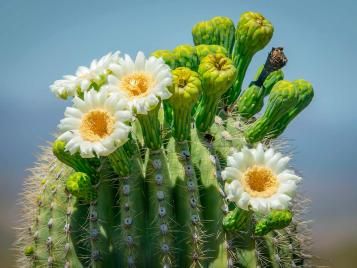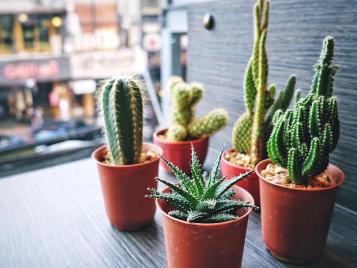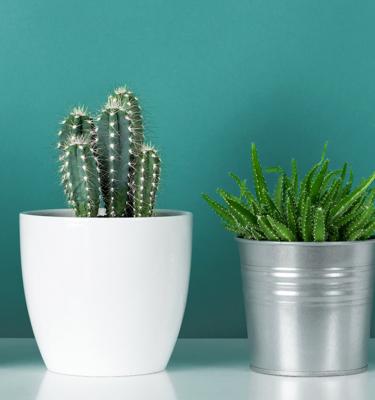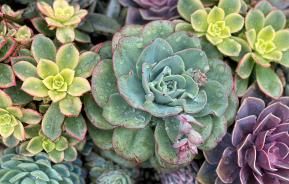Vast and diverse, it is not easy to provide general caring tips for the cactus and succulent group. Instead, we must begin by identifying your species. From small and delicate to larger and more striking, there is a cactus to suit every home.
The most commonly known identifier of cactus plants, is their ability to store water for long periods of time. Cactus are known to many as one of few plants that can survive in the dry environments of dessert land. What people don't know is that it isn't as simple to look after a cactus as you think.
Identifying your cactus
All types of cacti are succulents, however the defining factor of cacti are there areoles, which are not found in succulents. It is important to identify the specific species of cactus you are planning on keeping. For example, while many succulents grow in low moisture, high temperature, sunny climates, as seen in wild west films accompanied by cowboys and tumble weeds, some succulents actually grow in the rainforest (such as Epiphyllum). Therefore, it is important to be mindful of the native environment in which your succulent thrives, to provide the best possible growing conditions and achieve the best results.

Different cactus types
- Aporocactus Flagelliformis - Rat's Tail
- Cereus Peruvianus - Peruvian Apple
- Opuntia Microdasys - Bunny Ears
- Schlumbergera Bridgesii - Christmas
- Hatiora Gaertneri - Easter Cactus
- Disocactus Ackermannii - Orchid
- Echinocactus Grusonii - Golden Barrel Cactus
Creating the ideal environment for cacti
Once you have identified your cactus type, you need to create the right environment for it. You are looking for an open and free draining pot, this will prevent water-logging and best recreate the ideal habitat for your succulent. Cactis and succulents can be stored on a window sill all year round in the most part, however certain species such as Rhipsalis need to be positioned in a semi-shade environment, so ensure that you adhere to the requirements of your cactus. In terms of temperature, it is ideal to have a minimum of 8-10°C (46-50°F) at night time.
Looking after your cactus

The appropriate ways to care for your houseplant varies depending on the time of year. From April, water weekly and allow excess to drain away. In winter however, watering can be reduced. The key is to allow the compost to dry out between watering sessions, this applies all year round. If possible, water using tepid rainwater as the minerals in tap water can build up and cause deposits, damaging the leaves of succulents.
Some species of dessert-cacti can be left without water between November and February, so do your research to ensure you water correctly. During this time, winter-flowering succulents will need to be kept warm and be watered regularly, followed by a resting period in the summer. In the summer months try to provide adequate ventilation for your succulent(s). Finally, in terms of feeding, do so once a month throughout April to September using a relevant succulent feeding product.
Pruning cacti
Depending on the specie of houseplant that you have, pruning can help you make the most out of your cacti. Not always a necessary process, but when needed pruning can help maintain a fresh shape and look to your cactus. The occasional tidy can neaten outgrown specimens and thin over crowded areas. To further look after your cactus, the occasional dust can help keep the houseplant looking fresh, use a clean dust cloth when necessary.
Potential cactus problems
There are a number of things to look out for when growing cacti and actions you can take to limit potential problems. Here are the most common:
Cactus planting conditions
As emphasised throughout this article, the conditions in which you grow and care for your cactus greatly affect their health. Watering especially deserves particular attention, for example, too heavy watering can cause stunted growth and cause blistering. While, not watering enough can result in limited growth and shrivelling.
As well as temperature and watering routines, humidity and brightness should also be monitored to prevent potential problems. In situations where humidity is too high or the area is too bright, Cactus Corky Scab can be a result. Signs such as brown patches are an indicator, these then gradually shrink and form a scab. To prevent further scabbing, subtly reduce the humidity and light – however do not do so abruptly as this can cause undesirable affects.
Cactus pests and diseases
White patches may indicate Mealybug, while bronzed patches may be indicative of glass house red spider mite. Scale insects can be spotted on sighting of patching visible on the stems and leaves.
Rot is a common problems amongst the succulent family, with diseases such as Erwinia, fusarium and botrytis often causing infection in under or over watered plants. Another cause can be cold temperatures. If you suspect your cactus may have contracted one of these common diseases, treat with a fungicide as soon as possible.








